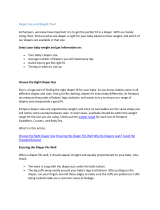Page is loading ...

Patient Care Instructions
for the 3M
™
Tegaderm
™
CHG
Chlorhexidine Gluconate IV Securement Dressing
What is CHG?
CHG stands for chlorhexidine gluconate. CHG is the antimicrobial
and antifungal antiseptic that is contained in the gel part of your
Tegaderm
™
CHG dressing. The CHG prevents bacteria from
growing on your skin.
What is the Tegaderm
™
CHG Chlorhexidine
Gluconate IV Securement Dressing?
The Tegaderm
™
CHG Dressing is the covering used over your
catheter site and it has 3 important functions:
1. To protect the catheter site from outside bacterial and
viral* contamination.
2. To help stabilize the catheter so it does not move or come out.
3. To reduce skin bacteria, a cause of catheter-related
bloodstream infection.
Because of these important functions of the dressing, it is
important to monitor your dressing so it can function properly.
How do I monitor my dressing?
You need to inspect your dressing daily. Call your healthcare
provider if you experience any of the following changes:
• The edges are starting to lift and no longer adhere to the skin
• The dressing has gotten dirty
• You can no longer see your insertion site
• You can see moisture under the dressing
• The gel pad of the dressing has absorbed too much fluid
Note: If you experience bleeding at your insertion site, call
your healthcare provider immediately.
Introduction
This patient guide is designed to help you monitor your 3M
™
Tegaderm
™
CHG dressing.
However, this is only a guide and should be used together with the advice of your healthcare provider.
Inspect
Daily
your dressing
*In vitro testing shows that the transparent film of the Tegaderm
™
CHG dressing provides a viral barrier
from viruses 27 nm in diameter or larger while the dressing remains intact without leakage.

How can I tell if the gel pad of the dressing has absorbed
too much fluid and the dressing needs to be changed?
It will be easiest to tell if the gel pad has absorbed too much fluid by getting to know
the gel when you first get home and inspect it daily to see if it changes.
When you get home, look at the size of the gel pad and touch the gel pad. You will
notice that it is firm. As the gel pad absorbs fluid, it will swell and get larger in size.
When you touch it, it will feel jelly-like and not firm to the touch. Push your finger on the
corner of the gel pad, it will not bounce back to the original shape if it has absorbed too
much fluid; the indent of your finger will remain after you take your finger away. The gel
pad may absorb too much fluid if you perspire or if you shower or bathe and the site
wasn’t properly covered.
These are signs that the gel pad has absorbed too much fluid and you should call your
healthcare provider.
What can happen if I let the dressing stay on my skin
when the gel has absorbed too much fluid?
You can think of the gel pad like a baby’s diaper. A baby’s diaper may be able to hold
an enormous amount of fluid, but that doesn’t mean that it should be left on the baby.
You would want to prevent skin irritation and change the diaper. Like the diaper, the
Tegaderm
™
CHG gel pad will continue to absorb fluid, which may lead to skin irritation
if the dressing is not changed.
Can I shower or bathe when wearing this dressing?
Follow any instructions given to you by your healthcare provider when it comes to
showering or bathing. When showering or bathing, make sure you use an additional
cover over your dressing to protect it from any water. If any water leaks into the
dressing, you should contact your healthcare provider.
Skin & Wound Care Division
3M Health Care
3M Center, Building 275-4W-02
St. Paul, MN 55144-1000
USA
1-800-228-3957
www.3M.com/healthcare
3M Canada Company
P.O. Box 5757
London, Ontario N6A 4T1
Canada
1-800-364-3577
www.3M.com/ca/healthcare
3M and Tegaderm
are trademarks of 3M.
Please recycle.
Printed in U.S.A.
Used under license in Canada.
© 3M 2011. All rights reserved.
70-2010-8047-3
Monitor
your
Dressing
Call your healthcare provider if you have any other questions.
/
